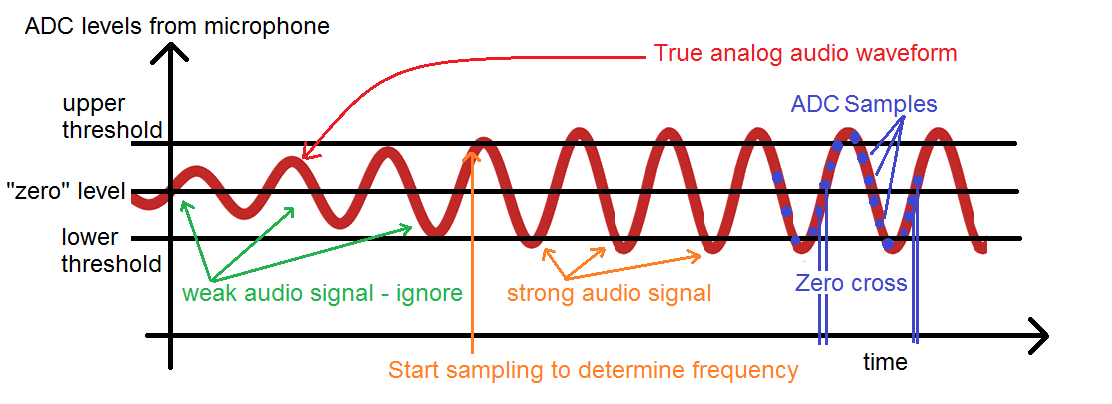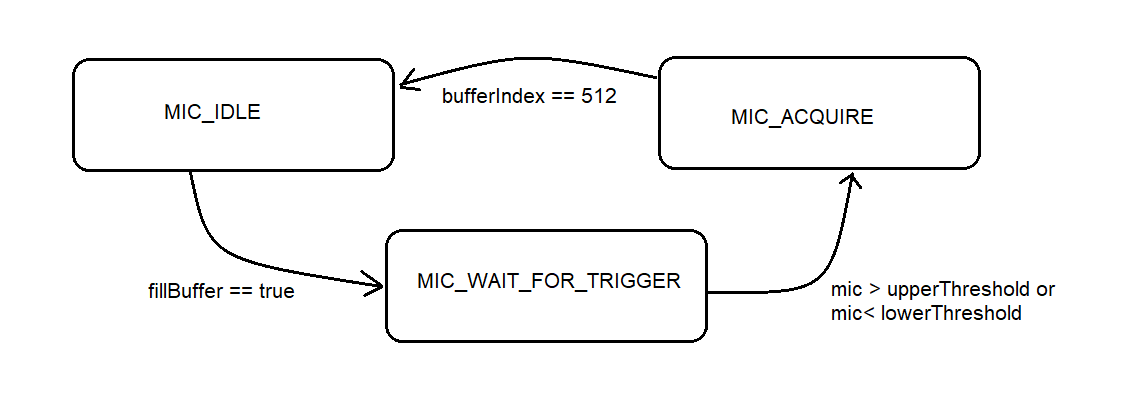EENG 383
Lab 8 - Microphone| Lab: | 8 |
| Status | Live |
InLab 8
Some self guided activities.Lab 8 assignment
Write a program that determines the frequency of a sin wave audio input provided by a whistle or audio function generator (like Keuwlsoft Dual Channel Function Generator for Android or Tone Generator Audio Frequency for iPhone). In order to ensure that you have usable data, your algorithm will wait until the sound level measured by the microphone exceeds a upper or lower sound threshold level as shown in the following image.
When enabled, the ISR will have the responsibility to:
- Determine if the ambient sound level exceeds either the upper or lower threshold,
- When this happens to fill a 512 byte buffer with audio samples collected from the microphone. These samples will be collected every 25µs. The buffer will be 512 bytes long - be careful with the data type of your counting variables (uint8_t can only count up to 256, not 512).
- When the buffer is full, set a flag true alerting main that the buffer is full.
- Have main scan the buffer, that was filled by the ISR, to determine indicies where the microphone samples increased past the value of 128. In other words, look for array indicies where buffer[index] ≤ 128 and buffer[index + 1] > 128. We will call these positive edge crossing because the microphone values are increasing through a threshold value, 128.
- Store all these positive edge crossing indicies into an array.
- Have main determine the number of indicies between adjacent positive edge zero crossing.
- Compute the average of all the periods collected and then print the average and, from this information, the frequency. There will be some further discussion below about how to do this so that you can extract the maximum amount of information from the data you have.
If you are having issues where the compiler complains that the PIC is "out of memory", move your large arrays out of main and make them global. Also, you do NOT need to make the zero crossing array have 512 entries. You should assume that someone whistling will produce a sine wave about 1.8kHz. In the example presented below, this creates 10 zero crossing. Doubling this value should be more than enough zero crossing for any realistic whistle.
ISR Details
Write the ISR to operate as a state machine using the following state diagram.

Use an enumerated type to define the states. You could use something like the following declaration.
typedef enum {MIC_IDLE, MIC_WAIT_FOR_TRIGGER, MIC_ACQUIRE} myTMR0states_t;
The ISR should use the switch/case structure to move between states.
Your ISR will need several static variable to keep track of the state
and the buffer index.
When you first get your program working, you will notice that your program reports the waveform periods lower than the input period. I will focus on period in this discussion because you will use the period information to fix this problem. For example, my program reports that a waveform with period 2500 µs (400 Hz) has a period of 2037 µs. This is difference of 463 µs represents time spent in the ISR. I want you to compensate for this time spent in the ISR by adjusting the initial count value of the TMR0 ISR by a fudge factor. The factor is not 463 µs, because this amount of time was distributed across the number of ISR calls made during one period of the input waveform. You should be able to calculate exact how many timer counts to include in your fudge factor. When you get it right, your program should be able to get within 50Hz of the true waveform.
At start-up your program should present a splash screen - this would be a great place for some ASCII art. The splash screen should also contain connection instruction for the development board; for this assignment tell the user there are no jumpers to install! When you press "?" at the terminal you should be greeted with the following menu.
------------------------------ ?: Help menu o: k Z: Reset processor z: Clear the terminal T/t: Increase/decrease threshold 138 - 118 f: gather 512 samples from the microphone and calculate the frequency ------------------------------
- ?
Prints out the ever useful help menu. Display the current upper and lower audio thresholds as part of the menu.
- z
Clear the terminal using a bunch of new lines.
- z
Reset the processor so that we can see that splash screen.
- T
Increase the upper threshold by 5 and decrease the lower threshold by
5. This allows you to decrease the sensitivity of the microphone to
ambient noise and requires a stronger audio input to trigger the
frequency measurement procedure.
At program start-up set the initial upper threshold to 128 + 10.
At program start-up set the initial lower threshold to 128 - 10.
- t
Decrease the upper threshold by 5 and increase the lower threshold by
5. This allows you to increase the sensitivity of the microphone to
ambient noise and requires a weaker audio input to trigger the
frequency measurement procedure.
At program start-up set the initial upper threshold to 128 + 10.
At program start-up set the initial lower threshold to 128 - 10.
- f
Calculate the frequency of audio waveform using the procedure
discussed above. Provide the following diagnostic information
as you work your way through the process. In order to reduce the
amount of text, I changed the NUMBER_OF_MICROPHONE_SAMPLES_TO_COLLECT
define in my program to 256. My program was designed to run with this
define set to 512. You may want to write your program with a define
like this - for initial testing set the define small (like 64) and then
later increase the define to 512.
The last 256 ADC samples from the microphone are: S[ 0]208 211 205 194 173 156 136 113 92 74 58 51 50 53 67 81 S[16] 95 114 135 157 176 193 202 210 206 199 185 165 148 122 101 85 S[32] 66 53 49 43 53 65 85 103 122 143 164 185 196 202 207 202 S[48]192 175 160 137 115 94 76 59 52 45 45 56 72 88 110 133 S[64]154 175 193 205 210 208 202 189 166 148 128 106 86 67 55 46 S[80] 46 52 62 81 99 120 138 159 181 197 203 202 204 191 182 163 S[96]139 116 94 70 62 49 44 43 50 66 84 105 129 150 167 188 S[112]202 204 207 198 185 170 150 130 109 84 67 53 44 47 52 58 S[128] 71 95 113 135 155 178 193 204 206 210 199 181 164 142 117 99 S[144] 77 62 51 47 47 54 62 78 101 126 143 163 182 197 204 210 S[160]201 192 171 155 132 111 92 73 59 49 47 49 58 74 90 108 S[176]130 152 171 185 201 208 206 198 188 173 151 130 104 82 67 55 S[192] 47 52 56 68 85 98 117 142 169 186 199 207 213 208 197 185 S[208]165 142 119 95 76 62 50 46 52 53 68 87 112 129 156 174 S[224]189 200 206 208 197 187 173 150 130 105 89 65 56 49 46 47 S[240] 57 75 90 112 136 161 175 191 203 209 206 197 185 162 138 118 The sound wave crossed at the following indicies 17 40 62 85 107 130 153 175 198 220 243 The sound wave had 10 periods 40 - 17 = 23 62 - 40 = 22 85 - 62 = 23 107 - 85 = 22 130 - 107 = 23 153 - 130 = 23 175 - 153 = 22 198 - 175 = 23 220 - 198 = 22 243 - 220 = 23 average period = 565 us average frequency = 1769 Hz
A "crossing" occurs when a microphone sample is less than or equal to 128 and the next microphone sample is above 128. The list of numbers below the text "The sound wave crossed …" are the indicies of the crossing values. For example, the 17th ADC value (remember to index from 0) is 114 and the 12th value is 145. Thus, 17 is stored (in an array) as a crossing point. You need to store all such crossing points in an array - this is the list 17 40 62 85 107 130 153 175 198 220 243. Associated with this, you will also need to have a variable that stores the number of crossings - in this case 11. The number of indicies between two consecutive crossings is the period of the waveform (in units of the sampling frequency).
Now, this brings us back to the last billeted point in the list of items that main is responsible for. In order to best utilize the information that you have, you should compute the average period and frequency as follows.- Loop through the crossing point array,
- For each index, compute the number of indicies between
adjacent crossing. This is done in the example above as the list
40 - 17 = 23 62 - 40 = 22 85 - 62 = 23 107 - 85 = 22 130 - 107 = 23 153 - 130 = 23 175 - 153 = 22 198 - 175 = 23 220 - 198 = 22 243 - 220 = 23
- Compute the sum of all these differences. Using the data above this is 23 + 22 + 23 + 22 + 23 + 23 + 22 + 23 + 22 + 23 = 226
- Since the period is being measured in terms of sample and there
are 25 µs per sample, the period (in µs) is just the
period in samples time 25. So, the average period (in µs)
as the sum * 25 / <NUMBER_OF_ZERO_CROSSINGS - 1>. Using the
data above, this is 226*25/10 = 526. Now this is the most
important point in this discussion, perform the multiplication
in the numerator before performing the division! Why?
Consider the data in our example; if you performed an integer divided 25 by 10 you would get either 2 or 3 depending on how the division is rounded, either way you would loose the fraction, 0.5 in this case. You answer, would be about 25% off from the correct value. Now if you perform the multiplication first you are dividing a reasonably large number by 10, reducing the impact of any rounding error. - Determine the frequency by taking the reciprocal of the period. Since your period is in terms of µs, you will need to introduce a factor of 1,000,000 into this express to get a frequency in terms of Hz.
Turn-in
You may work with a single partner (or alone) to complete this lab. Submit your main.c file on Canvas using the instructions posted there. You should take note of the Rubric that will be used to evaluate your assignment. Please form a group before submitting using the instructions posted on Canvas. You will demonstrate your code at the beginning of lab.
Your program will be tested using waveforms between 400Hz and 6kHz. My program was able to get within 1% of the actual frequency. Your program will be considered to be working correctly if it is within 2% of the test frequencies. Spend some time tuning that interrupt frequency!